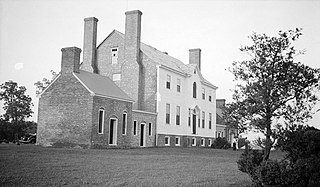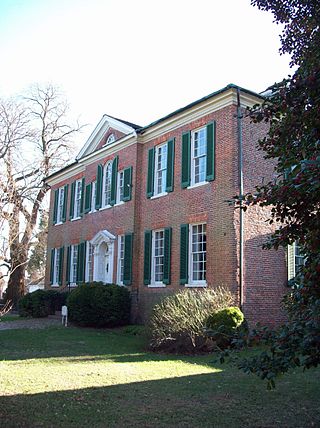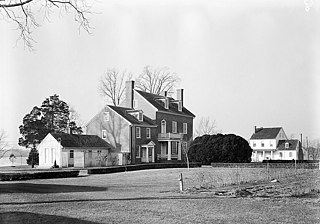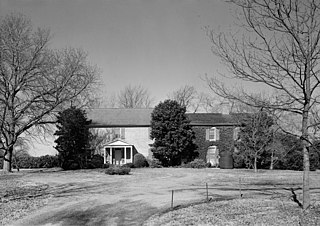
Charles County is located in Southern Maryland. As of the 2020 census, the population was 166,617. The county seat is La Plata. The county was named for Charles Calvert (1637–1715), third Baron Baltimore. Charles County is part of the Washington metropolitan area and the Southern Maryland region.

Port Tobacco, officially Port Tobacco Village, is a town in Charles County, in southern Maryland, United States. The population was 13 at the 2010 census, making Port Tobacco the smallest incorporated town in Maryland.

Marshall Hall, Maryland is the site of the Marshall family mansion. It is now part of Piscataway Park operated by the National Park Service. Marshall Hall is located near Bryans Road in Charles County, Maryland, next to the Potomac River, more or less across from Mount Vernon, Virginia, the home of George Washington. The home was one of the finest built on the Maryland shore of the Potomac in the early 18th century. The Marshall family were minor gentry and owned as many as 80 slaves by the early 19th century.

Maryland Route 6 is a state highway in the U.S. state of Maryland. The state highway runs 47.36 miles (76.22 km) from a dead end at the Potomac River in Riverside east to MD 235 in Oraville. MD 6 connects several small communities in southern Charles County and northern St. Mary's County with U.S. Route 301 in La Plata, the county seat of Charles County, and MD 5 in Charlotte Hall. The state highway also provides access to multiple historic sites around Port Tobacco, the original county seat of Charles County. MD 6 was one of the original highways numbered by the Maryland State Roads Commission in 1927. The state highway was constructed from La Plata to Riverside in the late 1910s and early 1920s. The La Plata–Charlotte Hall section of the highway was built in the mid-1920s. The portion of MD 6 east of Charlotte Hall was mostly built in the late 1920s and early 1930s. The final section of the state highway was completed in Oraville in 1940.

Darnall's Chance, also known as Buck House, Buck-Wardrop House, or James Wardrop House, is a historic home located at 14800 Governor Oden Bowie Drive, in Upper Marlboro, Prince George's County, Maryland, United States.

Rose Hill is a historic house built in the late 18th century near Port Tobacco in Charles County, Maryland, United States. It is a five-part, Georgian-style dwelling house. It has a two-story central block with gable ends. It was restored during the mid 20th century.

Mount Pleasant is 2+1⁄2-story brick structure with a gambrel roof and is about two-thirds its original length. It is located near Upper Marlboro in Prince George's County, Maryland. Mount Pleasant was patented in 1697 to Richard Marsham, whose wife Anne was the daughter of Leonard Calvert, Governor of Maryland. Their grandson, Marsham Waring, inherited the home from his grandfather in 1713. His son, Richard Marsham Waring had a son, Richard Marsham Jr., born in 1733, who then inherited Mount Pleasant and Patented and Certified the tract of land dubbed "Mount Pleasant Enlarged" in 1760. On August 21, 1764, Richard Marsham Jr. sold the 451+3⁄4 acre tract of land to his brother John for £474.6s.9d. John later built the standing house in the years between 1764 and 1785. John died in 1813 and was buried at Mount Pleasant.

The William Paca House is an 18th-century Georgian mansion in Annapolis, Maryland, United States. Founding Father William Paca was a signatory of the Declaration of Independence and a three-term Governor of Maryland. The house was built between 1763 and 1765 and its architecture was largely designed by Paca himself. The 2-acre (8,100 m2) walled garden, which includes a two-story summer house, has been restored to its original state.

His Lordship's Kindness, also known as Poplar Hill, is a historic plantation estate on Woodyard Road east of Clinton, Maryland. It was built in the 1780s for Prince George's County planter Robert Darnall. The five-part Georgian mansion retains a number of subsidiary buildings including a slave's hospital and a dovecote. The property is now operated as a museum by a local nonprofit preservation group. It was designated a National Historic Landmark in 1970.

Wyoming is a frame historic house located in Clinton in Prince George's County, Maryland, United States. It consists of three separate and distinct sections: the main block built in the third quarter of the 18th century, a ca. 1800 kitchen, and a connecting two-bay section of c. 1850. The house is a well-preserved example of Maryland's gambrel-roofed colonial architecture, and is more specifically noteworthy as an excellent example of southern Maryland tidewater architecture. With the exception of Mt. Pleasant, the house may have the oldest boxwood in the county planted on its grounds.

Dorsey Hall is a historic home in Columbia, Maryland, United States. It is a six-by-one-bay, 2+1⁄2-story stucco structure with a gable roof covered with asphalt shingles. It is a well-preserved and detailed example of the vernacular dwellings of the early 19th century in Howard County and associated with the Dorsey family, one of the "first families" of the county.

Locust Grove, also known as Beech Neck, is a historic home located at La Plata, Charles County, Maryland, United States. It is a two-story, three bay Federal style frame house, with a fine view of the Port Tobacco Valley. The original section of the house was built prior to 1750, with a significant expansion occurring about 1825.

Linden is a historic home located near Port Tobacco, Charles County, Maryland, United States. It is a rambling frame house, consisting of a 2+1⁄2-story main block with wings, embodying many traditional characteristics of Tidewater architecture. The house is situated on the crest of a hill overlooking the Port Tobacco Valley. The home was begun early in the 1780s and enlarged about 1800, and in the late 1830s. Linden was probably built as a summer residence about 1783, by Henry Barnes, a wealthy Port Tobacco merchant and on a property that remained in the same family for over 300 years.

Retreat is a historic home located at Port Tobacco, Charles County, Maryland, United States. It is a one-story, clapboard-sheathed, frame house with a double chimney. The principal part of the house was built about 1770. Also located on the property is a frame, pyramid-roofed meathouse, dating from the early 19th century, and moved here from another historic property in the county known as "Brentland" in 1953. The home, approached by a private gravel road, is surrounded by cultivated fields, meadows, and woodland, preserving its original agricultural and rural setting. The house is one of the earliest known examples of the side-passage, two-room dwelling in Charles County. It is associated with Daniel of St. Thomas Jenifer and Daniel Jenifer.

The Mt. Carmel Monastery is a historic monastery located at Port Tobacco, Charles County, Maryland, United States. It is a two-part frame house, the main block of which was built about 1790 and restored in 1936–37. It consists of a two-story structure with a moderately pitched gable roof. The entire house, devoid of any extraneous ornamentation, reflects the austere lives of the Carmelite nuns who are believed to have used this house as their residence.

Port Tobacco Historic District is a national historic district in Port Tobacco, Charles County, Maryland. It is located along both sides of Chapel Point Road immediately south of Maryland Route 6. It includes five surviving 18th- and 19th-century buildings; four have been privately restored as single-family residences. The fifth was renovated for use as a children's museum. Two of these buildings, Chimney House and Stagg Hall, are immediately adjacent to one another at one corner of the town square.

Potter Hall is a historic home located at Williston, Caroline County, Maryland, United States. It is an early-19th-century, Federal-influenced house facing the Choptank River. The house was constructed in three sections: a tall 2+1⁄2-story Flemish bond brick structure built about 1808 adjoining a lower 2+1⁄2-story, two-bay-wide central section built about 1750, also of Flemish bond brick, then a frame single-story kitchen wing added in 1930. Each of the three sections has a gable roof. Potter Hall was originally settled by Zabdiel Potter, who in the mid-18th century built a wharf and the small brick house. He developed Potter's Landing into a key early port for the shipping of tobacco to Baltimore.

Mount Harmon is an historic home, located at Earleville, Cecil County, Maryland, United States. It was listed on the National Register of Historic Places in 1974, and is currently open to the public.

Bowlingly, also known as Neale's Residence and The Ferry House, is a historic home located at Queenstown, Queen Anne's County, Maryland, United States. It is a large brick dwelling house constructed in 1733 on a bluff overlooking Queenstown Creek. The original house is a two-story brick structure that is seven bays long and one room deep, with flush brick chimneys at either end of the pitched gable roof. On August 13, 1813, a flotilla of British Royal Navy warships landed at Bowlingly's wharf during the War of 1812. British troops who disembarked from the warships proceeded to sack the home before being engaging the local Maryland militia.
Adrian Posey was an American politician, attorney, businessman and newspaper publisher from Charles County, Maryland.























